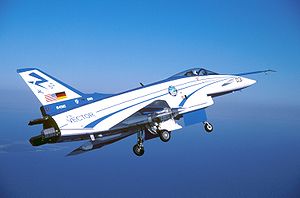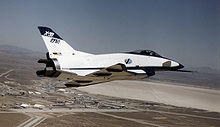Rockwell-MBB X-31 Video - Overview - Thrust Vectoring
|
|
Rockwell-MBB X-31
X-31

Picture - The X-31 aircraft returns from a test flight for VECTOR.
Role: Experimental
Manufacturer: Rockwell
Messerschmitt-Bolkow-Blohm
First flight: 1990
Primary users: DARPA
NASA, DLR
Number built: 2
The collaborative U.S.-German Rockwell-Messerschmitt-Bolkow-Blohm X-31 Enhanced Fighter Maneuverability program was designed to test fighter thrust vectoring technology. Thrust vectoring allows the X-31 to fly in a direction other than where the nose is pointing, resulting in significantly more maneuverability than most conventional fighters. An advanced flight control system provides controlled flight at high angles of attack where conventional aircraft would stall.
History
Two X-31s were built, with the first flying on October 11, 1990. Over 500 test flights were carried out between 1990 and 1995. The X-31 featured fixed strakes along the aft fuselage, as well as a pair of movable computer-controlled canards to increase stability and maneuverability. There are no horizontal tail surfaces, only the vertical fin with rudder. Pitch and yaw are controlled by the three paddles directing the exhaust (thrust vectoring). Eventually, simulation tests on one of the X-31s showed that flight would have been stable had the plane been designed without the vertical fin, because the thrust-vectoring nozzle provided sufficient yaw and pitch control.

Picture - The X-31 showing its three thrust vectoring paddles.
During flight testing, the X-31 aircraft established several milestones. On November 6, 1992, the X-31 achieved controlled flight at a 70-degree angle of attack. On April 29, 1993, the second X-31 successfully executed a rapid minimum-radius, 180-degree turn using a post-stall maneuver, flying well beyond the aerodynamic limits of any conventional aircraft. This revolutionary maneuver has been called the "Herbst maneuver" after Dr. Wolfgang Herbst, an MBB employee and proponent of using post-stall flight in air-to-air combat. Herbst was the designer of the Rockwell SNAKE, which formed the basis for the X-31.

Picture - Front-side view of the X-31 in OberschleixŸheim, Germany.
In the mid-1990s, the program began to revitalize and a $53 million VECTOR program was initiated capitalizing on this previous investment. VECTOR is a joint venture that includes the US Navy, Germany’s defense procurement agency BWB, Boeing's Phantom Works, and the European Aeronautic, Defense and Space Company in Ottobrunn, Germany. As the site for the flight testing, Naval Air Station Patuxent River in Maryland was chosen. From 2002 to 2003, the X-31 flew extremely short takeoff and landing approaches first on a virtual runway at 5,000 feet in the sky, to ensure that the Inertial Navigation System/Global Positioning System accurately guides the aircraft with the centimeter accuracy required for on the ground landings. The program then culminated in the first ever autonomous landing of a manned aircraft with high angle of attack (24 degree) and short landing. The technologies involved a differential GPS System based on pseudolite technology from Integrinautics and a miniaturized flush air data system from Nordmicro.
Serial numbers
BuNo 164584, 292 flights - Crashed January 19, 1995 north of Edwards AFB, CA. Crash was caused by ice inside the pitot tube, sending incorrect airspeed data to the flight control computers. Contributing factors included the replacement of a heated pitot tube with an unheated Kiel probe, and ground crew/pilot ignorance of an option to override computer control. The pilot ejected safely.
BuNo 164585, 288 flights. Now on display at OberschleixŸheim museum (part of Deutsches Museum).
Specifications (X-31)
Data from Jane's All The World's Aircraft 1993-94
General characteristics
Crew: one
Length: 43ft 4 in (13.21m)
Wingspan: 23 ft 10 in (7.26 m)
Height: 14 ft 7in (4.44m)
Wing area: 226.3 sq ft (21.02 m²)
Aspect ratio: 2.51:1
Empty weight: 11,410 lb (5,175 kg)
Loaded weight: 14,600 lb (6,622 kg)
Max takeoff weight: 15,935 lb (7,228 kg)
Powerplant: 1x— General Electric F404-GE-400 turbofan, 16,000 lbf (71 kN)(afterburning)
Performance
Maximum speed: Mach 1.28 (900 mph, 783 knots, 1,449 km/h)
Service ceiling: 40,000 ft (12,200 m)
Rate of climb: 43,000 ft/min (218 m/s)
Wing loading: 64.5 lb/ft² (315 kg/m²)
Comparison of 21st century fighter aircraft
Future Offensive Air System
Comparable aircraft
Grumman X-29
Boeing X-32
Lockheed Martin X-35
Dorr, Robert F. (1996). "Rockwell/MBB X-31". World Air Power Journal (London: Aerospace Publishing) (Volume 24 Spring 1996): pp. 34-47. ISBN 1 874023 66 2. ISSN 0959-7050.
Jenkins, Dennis R., Tony Landis, and Jay Miller. SP-2003-4531, "American X-Vehicles, An Inventory-X-1 to X-50". NASA, June 2003.
Lambert, Mark (1993). Jane's All The Worlds Aircraft 1993-94. Coudsdon, UK: Janes's Data Division. ISBN 0 7106 1066 1.
USAF & NATO Report RTO-TR-015 AC/323/(HFM-015)/TP-1 (2001).
Gallery
Rockwell-MBB X-31 in flight.
A diagram of the Herbst maneuver.
Rear view of the X-31 in OberschleixŸheim.
Rockwell-MBB X-31 Pictures and Rockwell-MBB X-31 for Sale.
Living Warbirds: The best warbirds DVD series.
Source: WikiPedia